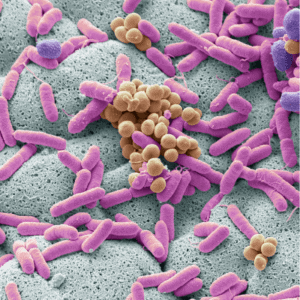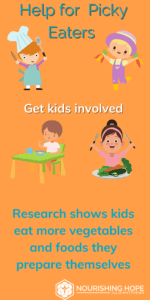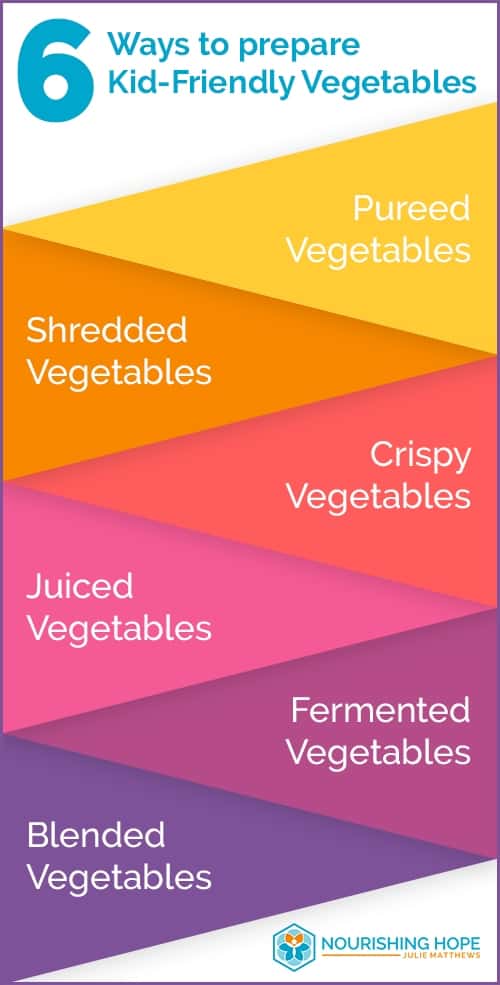
Picky eating is very common in children. 25% of children have a feeding disorder, and that number increases to 80% in children with developmental delays. [1]
So if you have a child who struggles with food, know you are not alone.
In fact, I’ve worked with hundreds of picky eaters in my practice since 2002. And I can safely say that virtually all, or at least a vast majority of my clients with autism were picky eaters. I’m here to share what has helped my clients, and what can help your child too!
And I can imagine that…
You may be frustrated trying to feed your child nutritiously when they are so restrictive.
You may worry about their nutrition intake, growth, and developmental milestones?
And if you are considering a special diet because you’ve heard going gluten-free and dairy-free diet can be helpful for certain children, you might feel overwhelmed about how to do that.
If you’re like many parents, you may be thinking, “My child is very rigid with their food intake and they eat mostly wheat and dairy. How will I ever get him to eat anything else? Never mind anything ‘healthy’, because they are too picky!’”
Don’t let that discourage you from trying diet. In fact, having a picky eater is an important reason TO try improving their diet and nutrition intake.
The good news is that once you understand what’s underlying their picky eating habits, there is a lot you can do!
It’s not simply behavioral. I don’t use “picky” in a judgemental way, rather a descriptive way: a common term many of us are familiar with. Certainly in some children it can be behavioral. But most often in my practice, I find that is not the case.
Many factors influence picky eating: sensory sensitivities, oral-motor challenges, anxiety, fears and medical conditions. For example, sensory sensitivities that can make certain textures offensive. Oral-motor challenges can cause children to gag or choke on food, which can lead to an avoidance of those foods. This is not uncommon with children with speech challenges where the tongue is not coordinated to form sounds and/or swallow properly.
But two big influential factors that are often overlooked are nutritional and biochemical: nutrient deficiencies and problematic foods.
In this article, we’ll investigate the deficiencies and problematic foods in our diet, and explore what you can do to help your child eat more varied, healthy food that is better for their body and mind. And we’ll explore feeding and meal ideas that help support children with sensory sensitivities.
Picky Eating is a Natural Stage
What causes picky eating? To some extent picky eating is natural and most of us that have had toddlers have experienced this.
As Lori Ernsperger and Tania Stegen-Hanson explain in their book “Just Take a Bite” picking eating due to food neophobia, fear of new food, is common in young children and seems to be a natural developmental stage between 2-3 years old. Most outgrow it by age 5.
Nature vs. Nurture
For ⅔ of kids, it’s nature, i.e. naturally inherited. However in 1/3 of children “nurture” can influence this condition. For example, When a child refuses a food and a parent removes the food assuming the child is rejecting it (rather than afraid of it), it supports the child’s fear.
Exposure to a variety of new foods helps get the child passed this phase, rather than turning it into a lifelong habit. [1]
Food neophobia can be due to behavior patterns or cognitive/developmental delay. And the good news here is that when we understand what is happening and why, we can intervene and help.
Autism and Picky Eating
Autism can be a reason for extremely picky eating. Exactly why we don’t know at this point. But I imagine there are differences in a child with autism’s brain that causes more feeding challenges. This is evidenced by a new picky eating study showing atypical eating behaviors among 70% of children with autism, versus 13% of children with other disorders, and only 4.8% of typical children. [2]
In this study, the most common behaviors for autism were limited food preference by 88%, hypersensitivity to food texture by 46%, eating only one brand of food (27%), pocketing food without swallowing (19%) and pica, which is eating non-food items like dirt (12%).
Additionally, 25% with ASD had 3 or more atypical eating behaviors vs. 0% of other children in the study. And only those with autism pocketed food or had pica.
This shows there is something special going on for children with autism. But it doesn’t mean you can’t help your child improve their picky eating. A vast majority of my clients with autism are picky eaters, and in addition to all of the reasons and strategies mentioned above, biochemical factors seem to be at play and in my experience addressing them can really help.
Biochemical Factors Affecting Picky Eating
The most common cause of picky eating I observe in my clients is due to biochemical reasons.
There are a number of biochemical reasons for picky eating; that can be addressed through particular attention to diet and nutrition. From a biochemical perspective, here are some solid reasons why children can be so one-sided in their food choices and become picky eaters:
Opioids
 The opioids in foods, like those found in gluten and casein, cause significant cravings/addictions. [3] These “addictions” cause children to self-select into a very narrow range of wheat and dairy based foods.
The opioids in foods, like those found in gluten and casein, cause significant cravings/addictions. [3] These “addictions” cause children to self-select into a very narrow range of wheat and dairy based foods.
What happens in the body is that gluten (wheat) and casein (dairy) are not digested properly and enter the bloodstream as partial proteins, i.e. opioids, that mimic the effects of morphine. They fit in opioid receptors in the brain and drive opiate (morphine-like) cravings/addictions. The child then becomes restricted to only the foods that fuel this addictive cycle, creating very limited and picky eating. As I said earlier, picky eating can be a reason or sign that your child may need a special diet.
It’s worth trying to interrupt the pattern, because once the child moves passed the cravings (a few days to a few weeks), their food choices expand dramatically and it becomes much easier to follow a special diet.
Most of my clients’ children with autism, initially eat limited amounts of vegetables, if any at all. Routinely though, once they begin a diet (and the cravings diminish and appetite increases), children begin eating more vegetables (or meat) – often for the very first time. Most of my clients report this type of positive experience after progressing with diet.
Food additives
 “Preferences” for food additives (MSG, artificial flavors) can cause strong cravings for processed foods, even restriction to one brand. These chemicals can also be addicting. MSG is known to create “excitement” in the brain by stimulating the glutamate (excitatory) receptor, making food seem to taste much better. [4] Artificial ingredients such as artificial flavors can also affect similar preferences, and subsequent cravings. Be aware that brand preference may be due to MSG or other additives that can be additive, making that food taste “exciting.”
“Preferences” for food additives (MSG, artificial flavors) can cause strong cravings for processed foods, even restriction to one brand. These chemicals can also be addicting. MSG is known to create “excitement” in the brain by stimulating the glutamate (excitatory) receptor, making food seem to taste much better. [4] Artificial ingredients such as artificial flavors can also affect similar preferences, and subsequent cravings. Be aware that brand preference may be due to MSG or other additives that can be additive, making that food taste “exciting.”
Nutrient deficiencies
 Nutrient deficiencies, particularly zinc deficiency, can make foods taste bland or uninviting. When zinc is deficient (a common finding in children with autism), one’s sense of smell is reduced and food tastes uninteresting or unappetizing. [5] Texture can then become an even bigger factor – imagine eating mashed potatoes if you can’t taste the potato flavor – it’s a bland mouthful of mush.
Nutrient deficiencies, particularly zinc deficiency, can make foods taste bland or uninviting. When zinc is deficient (a common finding in children with autism), one’s sense of smell is reduced and food tastes uninteresting or unappetizing. [5] Texture can then become an even bigger factor – imagine eating mashed potatoes if you can’t taste the potato flavor – it’s a bland mouthful of mush.
Microbes
 Yeast, viral, and microbial overgrowth may cause hyper focus on eating mainly high carbohydrate and sugar rich foods. Yeast and other microbes feast on carbohydrates and sugar. They can actually get their “host” (your child) to crave the food that feeds them by giving off chemicals that get kids to crave refined carbohydrates and sugar. This can create self-limitation to only these foods.
Yeast, viral, and microbial overgrowth may cause hyper focus on eating mainly high carbohydrate and sugar rich foods. Yeast and other microbes feast on carbohydrates and sugar. They can actually get their “host” (your child) to crave the food that feeds them by giving off chemicals that get kids to crave refined carbohydrates and sugar. This can create self-limitation to only these foods.
There are some children that are very self-limiting and may require additional assistance to broaden their diet. Feeding therapists and various therapies can really help. Also there are medical issues so be sure to ask your doctor as well.
NOTE: Don’t remove all foods with the expectation that “if they’re hungry, they’ll eventually eat.” While this may be true for many children, some have real feeding problems and may stop eating altogether, which could be very problematic. Add new foods before removing others. Be sure to seek professional guidance from a feeding specialist or qualified clinician if your child won’t add any new foods.
Once you’ve identified possible causes of your child’s finicky eating habits, begin to look for creative ways to address them and get support when you need it. If you have your child’s trust around food and you’re able to make some changes to your child’s diet, consider the following ideas.
Introducing new foods on a special diet
Don’t let picky eating stop you from implementing a special diet.
 Indeed, addressing these issues is essential to the effectiveness of any specialized diet because sometimes the diet won’t expand until certain foods are removed. So, before implementing a special diet try to identify new (replacement) foods your child will eat. Then, after the problematic or addictive foods are removed, see if your child will expand their diet little by little.
Indeed, addressing these issues is essential to the effectiveness of any specialized diet because sometimes the diet won’t expand until certain foods are removed. So, before implementing a special diet try to identify new (replacement) foods your child will eat. Then, after the problematic or addictive foods are removed, see if your child will expand their diet little by little.
In other words, find several breakfast, lunch, dinner, and snack options for the new diet, often making one-for-one substitutions with foods they already eat. This way, you are not removing any foods in an already restrictive diet. After initiating the new diet, such as GFCF, then begin to try adding new foods and some vegetables of varied texture. Even if your child has been on a diet for a while or has not yet begun to implement a new diet, there are suggestions below that can be helpful for getting new and nutritious foods into the diet.
Nourishing hope takes persistence and patience; even the pickiest eaters can progress and benefit from improved diet.
There are many strategies for feeding therapies. You can find a profession that practices one of these therapies and they can help you.
Here are some ideas I have had clients use to help their child who was a picky eater become introduced to new foods:
- Involve your children in food preparation. From gardening, washing, chopping, and cooking to watching. Anytime your child participates is positive.
- Always provide food your child likes in addition to one “new” food
- Don’t require them to do anything other than get familiar with it. Consider incorporating the food into therapy or play time.
- Inform them. Let your child know whether it is sweet, salty or sour. Eat some yourself and tell them how delicious it is.
- First have them touch it, lick it, or chew it without eating/swallowing it.
- Start with only a small taste ~ 1/2 teaspoon. Let your child determine the amount.
- Try and try Again! At least 15 times!
- Get creative. Try new food in preferred texture – crunchy, smooth.
- Avoid being emotionally “attached” – children sense anxiety. Keep mealtime calm. Visualize your child eating/enjoying new food.
- Avoid forcing or pushing – maintain trust.
- Choose rewards or other encouragement – however not food-based rewards.
- Make sure your whole family participates – serve everyone at the table.
- Make it fun!!
Get Kids Involved in Preparing Food
 Let’s breakdown the first point above: Involve your children in food preparation. Growing food and preparing foods are two great ways to improve healthy food preferences and consumption, like vegetables.
Let’s breakdown the first point above: Involve your children in food preparation. Growing food and preparing foods are two great ways to improve healthy food preferences and consumption, like vegetables.
In a study of 5 to 7 year olds, researchers found children ate more of a food they prepared themselves compared to the same food prepared by someone else, including healthy foods/vegetables. [6] In this study, they found the children ate more salad when they prepared it themselves.
In a study involving 4th-6th graders gardening, researchers found an “increase in the number of fruits and vegetables ever eaten, vegetable preferences, and fruit and vegetable asking behavior at home.” [7] A vast majority of the children, over 90% enjoyed taste-testing fruits and vegetables, preparing fruit and vegetable snacks, working in their garden, and learning about fruits and vegetables.
Below are ideas for getting more nutrition in your child’s diet, healthy vegetables kids like, and recipes you and your child can try at home.
Food Ideas for Increasing Variety and Nutrition
Be creative! Begin to add vegetables where you can and slowly introduce foods slightly differently than they had before. See if you can make food a little different each day – not so much that they reject it, but just enough that they don’t expect sameness – and to get in new nutrients.
Add enough salt to make your versions of their favorites more flavorful–don’t go overboard but don’t feel you need to limit salt either.
Try mixing or diluting a brand of food/beverage they like with a healthier version in very small amounts until the item is swapped for the new food-this works well for milks, peanut/nut butters, apple sauce and other foods that blend well.
Give your child a “mini meal” during snack time rather than “snack foods” so your child does not fill up on empty calories. And is hungrier for their next meal, should they skip snack.
Be sure to always keep your child’s trust around eating. If they are extremely picky eating habits do not try “sneaking” things into your child’s favorite foods as they may lose trust and reject the food altogether in the future. With that said, many children do well with “incorporating” (i.e. hiding/sneaking) foods into other foods. If you are unsure, ask a feeding therapist for advice.
And most importantly, pay attention to the texture of the food.
Texture is key
Addressing texture is very important with picky eating. Researchers have found that oral/sensory sensitivity is often found in children with picky eating habits – it was found both in children with ADHD and autism. [8]
So choosing the right texture for your child can help immensely with their selective/picky eating preferences, and help broaden them.
Based on your child’s preferences, get creative in making healthy foods like vegetables crunchy, smooth, or whatever their desired texture. Add purees to pancakes, applesauce, meatballs, or sauces. Make vegetables crunchy by making carrot chips, sweet potato fries, or vegetable latkes. Hide meat in pancakes (chicken pancakes).
I find that crunchy is the most preferred texture.
Here are some good tasting and creative ideas for introducing vegetables that come from Cooking To Heal, my cookbook and instructional videos.
6 Ways to Prepare Vegetables
 1. Pureed vegetables:
1. Pureed vegetables:
- Add to muffins
- Add to pancakes 1⁄4-1/2 cup puree per cup of pancake mix
- Include in meatballs, meat patties, and meatloaf
- Mix into sauces such as tomato sauce
2. Shredded vegetables:
- Add shredded beets to chocolate cake for birthdays (let other parents know)
- Add shredded carrots to muffins
- Add shredded vegetables like zucchini to latkes, pancakes, or bread
3. Crunchy vegetables:
- Make vegetables into crispy, crunchy chips (like potato chips). Use carrots, sweet potatoes, butternut squash, beets, parsnips, or other roots or dense vegetables.
- Try baked chips such as kale chips
- Pan-fried shredded vegetables and potatoes make a great crunchy hash-browns or latkes (see recipe below)
4. Juiced vegetables
- Juicing vegetables is a great way to prepare vegetables in a texture kids like. Kids like juice! Juicing vegetables is high in concentrated nutrients and tastes good
5. Blended/Smoothie vegetables
- Adding vegetables to a smoothie is a great way to get vegetables into a child’s diet. If the child is on the more finicky side, start with vegetables that are not green like carrots.
- Green vegetables like kale are great in a smoothie. Just be careful not to use spinach, as it’s too high in oxalate. (see recipe below)
6. Fermented vegetables:
- Shred apple and add 50/50 with raw sauerkraut to reduce sourness. Serve as shredded fruit salad
- Puree raw sauerkraut or other cultured vegetables in food processor with applesauce (or other fruit sauce)
Getting Enough Protein
Meat can be chewy and tough. For kids with poor mitochondrial function and low muscle tone, meat can be simply too much effort.
Often children gravitate toward carbohydrate rich, starchy snacks that provide quick energy, are addictive, and easy to chew. Unfortunately, this can mean they miss out on adequate protein.
For children who do not like the texture of protein, try pureeing cooked chicken breast and add it to muffins or pancakes. Here are some ideas for getting protein and animal foods in your child’s diet.
- Add a small amount of pureed cooked chicken (approximately 1⁄4 cup, less to start) to a regular pancake or muffin recipe.
- Chicken pancakes are simply a chicken breast and three eggs blended in a food processor into a batter and poured into a pan and cooked like any pancake.
- Homemade bone broths are rich in nutrients. Use broth for soups or stews. Cook grains or pasta in broth. Add concentrated homemade broth to sauces.
Recipes
Vegetable Latkes
GFCF/ SCD/GAPS/ Paleo/LOD/BED, Nut-Free
Ingredients
3 cups shredded zucchini
1 head of cauliflower
1 onion
2 eggs
Salt/pepper (white pepper for LOD)
Oil for pan-frying (Coconut or ghee)
Directions
Place zucchini in a towel and twist out water. This is a crucial step. Let zucchini drain as much as possible. Cut cauliflower and steam until vegetable is soft – able to easily mash with a fork. If watery, place in towel and wring out water.
Heat oil and sauté onions until caramelized. For ease, skip the sautéing and use raw finely chopped onions.
Combine zucchini, cauliflower, and onions in bowl. Add eggs, salt and pepper. Mix with hands.
Heat until browned and egg is thoroughly cooked. Variation: Add other shredded vegetables such as carrots.
Green Smoothie
GFCF/SCD/GAPS/Paleo/LOD
Because of kale and these other low and medium oxalate ingredients, you can enjoy this green smoothie as part of a low oxalate diet. Choose low oxalate berries like strawberries and blueberries, and make sure to consider serving size to keep with a low oxalate diet.
Ingredients
1 cup mango (fresh or frozen)
1/2 cup berries (fresh or frozen)
1 banana
1/2 avocado
5 kale leaves de-stemmed (about one cup of kale)
12 oz of water, or fresh fruit or vegetable juice
2 dates (optional if the berries are on the sour side)
Blend together in a blender and serve.
You can do it! Step-by-Step Progress
While it may be frustrating to cook food and have your child refuse it, try your best to avoid projecting negative energy or frustration. Children are very sensitive and pick up on your cues, which affect how they feel in general and about the food you are serving.
Also, is/was mom or dad a picky eater? If so, try having the other person, who can project calm, positive feelings about the food, feed the child.
Set yourself up for success by making sure that each meal includes something you know they will eat, along with the new food. Or, when they are hungry at snack time, try a new food. This is a good time to do so because while they may skip a snack, they will not be going without a main meal, and you won’t teach them that if they hold out you will prepare them something new. They will also be a little hungrier at dinner and may be more motivated to try a new item.
Getting good nutrition is essential to good health and healing. Begin a special diet and add nutritious foods step by step. You can do it – and your child can too!
I have seen many, many children expand their diet. Once food addictions, texture, and exposure to a new food are addressed, you’ll be surprised what your child can eat.
I teach these principles to parents in my nutrition program for parents, and the results are exciting.
 One mom in my program reported back to me about her son, “He is eating vegetables like never before and is more willing to experiment or taste new things. I don’t force anything at all ”
One mom in my program reported back to me about her son, “He is eating vegetables like never before and is more willing to experiment or taste new things. I don’t force anything at all ”
Children can change and improve their eating habits. I’ve seen it hundreds of times.
Imaging them doing it. Get creative. Try things in a texture they like. Taste it yourself and make sure it tastes good. Involve them as much as you can.
You’ll be pleasantly surprised when they eat that first vegetable, and more! “Nourishing hope” takes persistence and patience; even the pickiest eaters can progress and benefit from a special diet – including your child.
I’d love to hear your story to inspire other families.
Julie




Our fussy eater eats crunchy foods. If I freeze dry vegetable soup— she eats it. Freeze fried bananas strawberries and raspberries have also worked. Not in their fresh form though
Thanks for sharing your experience, Angelica!
Thanks so much Julie for this wonderful practical comprehensive information …FOR FREE ! I am really grateful for your generous spirit in sharing your expertise for the potentially “ life – changing “ benefit of everyone …🙏🏻 for the expansion of your influence in medical fields so that this kind of vital nutritional information becomes “ mainstream “ among family doctors etc …truly “Nourishing Hope “ 😃 !